|
|
|
Sort Order |
|
|
|
Items / Page
|
|
|
|
|
|
|
| Srl | Item |
| 1 |
ID:
116571
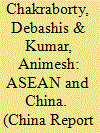

|
|
|
|
|
| Publication |
2012.
|
| Summary/Abstract |
ASEAN and China share a complex relationship in economic terms; while they collaborate in several spheres, conflict of interests is not uncommon either. The proposal for an ASEAN-China Free Trade Agreement (ACFTA) was floated in 2000, and the agreements covering merchandise trade, services trade and investment collaboration were signed in 2004, 2007 and 2009 respectively. ASEAN countries agreed to consider China as a market economy in the course of the negotiations and the ACFTA has resulted in several benefits for both parties, including tariff reduction on substantial number of product lines, considerable growth in merchandise and services trade volume, deepening of intra-regional production networks, regional cooperation on infrastructural development and so on. However, rapid growth of Chinese imports in ASEAN markets and expanding trade deficit generates apprehension in the grouping over potential domestic restructuring. Subisidies provided by the Chinese government to its domestic players also compound the problem. This article concludes that ASEAN countries need to augment their competitiveness through coordinated efforts on the one hand, and jointly negotiate with China to curb the disruptive effects of the latter's incentive programmes, on the other.
|
|
|
|
|
|
|
|
|
|
|
|
|
|
|
|
| 2 |
ID:
116566


|
|
|
|
|
| Publication |
2012.
|
| Summary/Abstract |
The rise of China has brought forth new sets of opportunities and challenges for Southeast Asia. A new politico-strategic landscape has emerged in which, ASEAN not only seeks China's economic support perceived to be crucial for the development of the region, but also worries about China's growing power and the possibility of Chinese domination over the region. ASEAN as a regional interlocutor has responded to the new phenomenon by deploying a hedging strategy that seeks to benefit from the opportunities and manage the challenges emanating from the rise of China. While ASEAN's policy of 'honest brokerage' has allowed the presence of other powers to balance China, its policy of enmesh China has facilitated China's role as a stakeholder in the ASEAN cooperative processes.
|
|
|
|
|
|
|
|
|
|
|
|
|
|
|
|
| 3 |
ID:
116568
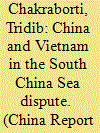

|
|
|
|
|
| Publication |
2012.
|
| Summary/Abstract |
The South China Sea dispute which has spilled over from the twentieth to the twenty-first century, is yet to find an amicable solution. The root cause of this tension is the dispute among the various claimants as regards the procurement of energy resources and securing territorial legitimacy. The entry of the US into the picture has further complicated the problem. In order to evolve a congenial regional environment, the disputing countries must evolve a collaborative outlook, not confrontationist, and adopt a regional perspective rather than proceed from their national interest only and take recourse to multilateral mechanisms as a means to reduce tension in the region. If the prognosis that the '21st century is the century of Asia' is to be made a reality, then the economic prosperity and development of the Asian region will be essential, for which, all the disputing countries should change their mindset from local to global level and keep the South China Sea region as less tension-prone as possible.
|
|
|
|
|
|
|
|
|
|
|
|
|
|
|
|
| 4 |
ID:
116570
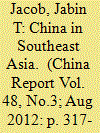

|
|
|
|
|
| Publication |
2012.
|
| Summary/Abstract |
Despite China's claims of a foreign policy of 'peaceful rise'/'peaceful development' and of seeking a 'harmonious world', and despite its economic openness and active participation in economic multilateralism, China's neighbours continue to be concerned about the overall direction and intent of Beijing's security policies. These concerns are particularly heightened by China's rapid military modernization of the past couple of decades. The announcement in 2010 that China considered its territorial claims in the South China Sea a 'core interest', can be seen as a setback to its regional diplomacy, so diligently crafted over the years and drove its Southeast Asian neighbours to seek closer engagement with the US. This article argues that the contradictions evident in China's neighbourhood foreign policy reflect its continuing search for a model of international relations that can balance its domestic interests such as the need for political stability, including regime stability, on the one hand and its external ambitions for a decisive role in regional affairs, on the other.
|
|
|
|
|
|
|
|
|
|
|
|
|
|
|
|
| 5 |
ID:
116564


|
|
|
| 6 |
ID:
116565
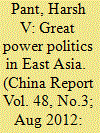

|
|
|
|
|
| Publication |
2012.
|
| Summary/Abstract |
China's rise has altered the strategic realities in East Asia with the US having to manage a power transition in the region. The signals from Washington that it would not allow growing Chinese power in Asia-Pacific to go unchallenged have become unambiguous. The region is witnessing great power politics at its most pristine and geopolitical competition between the global superpower and its most likely challenger is in full swing. This article outlines the changing strategic realities in East Asia with China's rapid ascent in global hierarchy and argues that the US has had to recalibrate its regional policy in response to the growing demand from the region for it to play a more assertive role if it wanted to retain its role as an offshore balancer.
|
|
|
|
|
|
|
|
|
|
|
|
|
|
|
|
| 7 |
ID:
116572


|
|
|
|
|
| Publication |
2012.
|
| Summary/Abstract |
Among all the people who have left mainland China's shores, it is the Chinese diaspora in Southeast Asia that is the most important, not only for the numbers but also for the economic contribution they made for both the host as well as the home countries. The economic organisation of the Southeast Asian Chinese has been unique in many respects and many studies show their retention of ancient cultural practices which proved to be their strength during the post-colonial era. This article is an attempt to look at the historical trajectory of Southeast Asian Chinese, their unique business practices and how globalisation has been an element of change in terms of their outlook towards making use of business opportunities and searching for new models and patterns to survive and succeed in the global economy.
|
|
|
|
|
|
|
|
|
|
|
|
|
|
|
|
| 8 |
ID:
116569
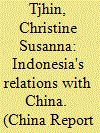

|
|
|
|
|
| Publication |
2012.
|
| Summary/Abstract |
This article looks into the recent development of Indonesia's relations with China. Notable progress can be seen in political and security relations, despite the fact that this dimension was at the core of their contentions during the 1970s and caused a freeze in diplomatic relations until the early 1990s. Economic relations, on the other hand, have long been the backbone of relations even before normalisation, but after Reformasi, economic relations have gradually been depicted as a new kind of threat even as they flourish. A unique factor contributing to this relationship is the distinctive role of Chinese Indonesians. This article also considers participation in multilateral diplomacy as an important aspect and strategy that affect bilateral relations. Under democracy, Indonesia is able to formulate a more productive and pragmatic China policy. However, since productive and pragmatic relations are not sufficiently strategic, Indonesia needs to formulate a long-term strategy to engage China and substantiate the so-called strategic partnership.
|
|
|
|
|
|
|
|
|
|
|
|
|
|
|
|
| 9 |
ID:
116567
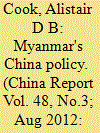

|
|
|
|
|
| Publication |
2012.
|
| Summary/Abstract |
Over the past two decades there has been increasing international attention to the interactions between Myanmar and China. While China has significant influence in relation to other international actors, there is also significant calculation by the government in Myanmar in an effort to ensure that no single external actor calls the policy shots. Instead, the policy choices of the government illustrate that they are calculated on a case-by-case basis to respond to emerging security threats and challenges. However, this represents only a partial truth because there are myriad actors competing for legitimacy in Myanmar which also have various relationships with external actors. Indeed, to fully understand the relationship between Myanmar and China a multifocal lens is required to appreciate the nuances and tensions within Myanmar and their effects on its overarching relationship with China. Furthermore, this lens must also be applied to China, as it too has multiple levels of engagement with Myanmar at both formal and informal levels to varying degrees. This article analyses this complex web of interactions to provide insight into the various agendas, strategies and challenges at play in the relationship between Myanmar and China.
|
|
|
|
|
|
|
|
|
|
|
|
|
|
|
|
|
|
|
|
|